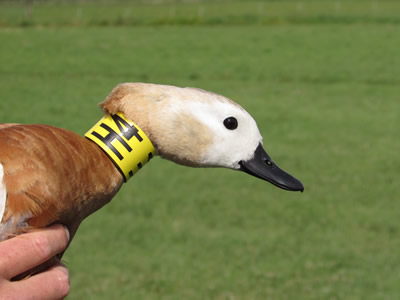Date:
Until 2013 many have wondered what the origin is of the ever increasing numbers of moulting ruddy shelducks on the Eemmeer in the Netherlands. During recent years up to 800 birds were present. Other areas (IJsselmonding and Lauwersmeer) have also seen increasing numbers of moulting ruddy shelducks. The origin of these birds is unknown. It was always assumed that they were escaped birds from private waterfowl collections and their offspring. However, the numbers surpass those of the Dutch breeding population by far. It is know that the German breeding population is still increasing, so that could be a potential source.
 |
| Ruddy shelduck with neckband - foto Guido Keijl |
It is possible that the birds that moult at Eemmeer are wild birds, possibly from Eastern Europe or even further away. The European breeding population is concentrated in the region around the Black Sea, in South-eastern Russia and Transcaucasia. If the moulting birds are indeed (partly) wild, then this may have consequences for the conservation status of the species, and for Special Protection Areas (SPAs) in the Netherlands where the species occurs in significant numbers. Ruddy shelducks are are classified as ’Vulnerable‘ and have a relatively small population size.
The use of neckbands and transmitters can illuminate the riddle of the ruddy shellduck. With this aim, a special working gropup was formed consisting of Ruud van Beusekom, Sjoerd Dirksen, Ton Eggenhuizen, Dick Jonkers, Erik Kleyheeg and Frank Majoor.
In July 2013 827 ruddy shelducks were couted at Eemmeer. Of those, we caught 49, all of which (except one) received an individually-coded yellow neckband. A small number also received a GPS-GSM transmitter. The young of a local breeding pair in Limburg have also been bneckbanded.
We are building a website where the the results of the project will be shown: www.werkgroepcasarca.nl. We are also active at twitter: @WgCasarcaNL
Contact the working group at: s.dirksen@xs4all.nl